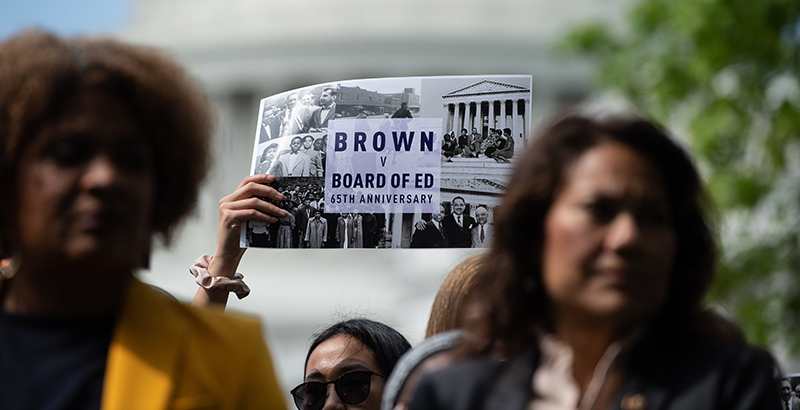Robinson & Lowery: 65 Years After Brown v. Board, Using the Lens of History to Reassess What We Should Be Expecting From the K-20 Education System in 2019

In September 2019, 56.6 million school-age children, 3.7 million teachers, and 200,000 principals and support staff will walk through the doors of public and private pre-K-12 schools. At the same time, other students will learn at home, online or in another learning environment.
This school year opens with the highest enrollment ever reported for public schools. Inside of them is an ever diversifying student population. This includes the following: 23.7 million white students, 13.9 million Hispanic students, 7.7 million black students, 2.7 million Asian students, 2.1 million students of two or more races, 500,000 American Indian/Alaska Native students and 200,000 Pacific Islander students. Although the white student population is shrinking as a percentage of overall enrollment, many of our public schools remain highly racially identifiable.
At the postsecondary level, 19.9 million students will enroll in approximately 4,298 degree-granting postsecondary institutions. Women account for 56.7 percent of higher education students. Historically Black Colleges and Universities are an essential member of our higher education ecosystem, and they are located in 19 states, the District of Columbia, and the U.S. Virgin Islands.
To measure the tenacity for what we expect from K-20 education in 2019, we must look at the state of American education in 1954. Why this year? This is when the Supreme Court ruled that separate but equal had no place in public education in the famous Brown v. Board of Education decision. As we reflect back on this special moment in American history 65 years ago, we have to look at the progress made — and the challenges and opportunities ahead.
Some people believe we have made tremendous progress. For example, 36.4 percent of white students had completed high school or higher in 1950, compared with only 13.7 percent of blacks. Fast-forward to 2017: 94.1 percent of whites, 88.1 percent of blacks, 70.5 percent of Hispanics and 90.9 percent of Asians have completed high school or higher. More students who qualify for the National Lunch Program are going to and through college at a higher rate than they did in earlier decades. Many of them work in private- and public-sector jobs from which they would have been barred because of their race or gender in 1954.
However, challenges still abound. According to results from the National Assessment of Educational Progress, also known as the Nation’s Report Card, our students are not doing well. In 2017, our nation’s fourth-graders did not score proficiently — their average reading score was 222 out of 500 points, and 240 out of 500 points for mathematics. To be considered proficient in reading, a student must score at least 238, and for math, at least 249. America’s eighth-graders did not fare well either, although states such as Arizona, Florida and Virginia are plowing ahead.
Issues other than test scores also negatively impact our schools. Bullying, the school-to-prison pipeline, teacher absenteeism and funding disparities are a few examples.
With these factors in play, we ask one question: Why does Brown still matter to us today?
To address the 65th anniversary of the landmark decision, The Brown Foundation for Educational Equity, Excellence and Research, in partnership with The Thurgood Marshall College Fund, The Walton Family Foundation and The 74, will host an event on Tuesday, Sept. 17, at 12:00 p.m. ET at The Gallup Building in Washington, D.C. To help us understand what occurred 65 years ago — and what has happened since — we have two people who were on the ground level when Brown was decided.
Cheryl Brown Henderson is one of three daughters of the late Rev. Oliver L. Brown, who, in the fall of 1950, filed a lawsuit with 12 other parents on behalf of their children against the Topeka Board of Education in Kansas. Their case was joined with cases from Delaware, South Carolina, Virginia and Washington, D.C., and became Brown v. Board of Education. Brown Henderson will discuss her book, Recovering Untold Stories: An Enduring Legacy of the Brown v. Board of Education Decision. It is a collection of essays from the plaintiffs and descendants of plaintiffs.
She will be joined by John Stokes, a student plaintiff in the Virginia desegregation case. He grew up in the Jim Crow South and attended Robert Russa Moton High School, a segregated school for African Americans located in Prince Edward County. Recognizing the inequalities he and his classmates faced, Stokes, Barbara Johns and others staged a walkout and refused to return to class until their school was rebuilt. He chronicles this story in a book titled The Strike.
The Tuesday panel will also include Philippa Smithey, national director of the Children’s Defense Fund, and Alonzo Smith, professor of history at Montgomery College.
It is important to have conversations about the reality of the world we live in now — and decades before — to ensure knowledge and history are passed along to new generations. This is particularly important when education, public policy and opportunity are part of it. Without conversations of this nature, we may repeat the problems of the past and bypass the new roads ahead.
Gerard Robinson is the executive director of the Center for Advancing Opportunity.
Marcus Lowery is the administrative coordinator for the Center for Advancing Opportunity and a graduate of Virginia State University.
Disclosure: The Walton Family Foundation provides financial support to The 74.
Get stories like these delivered straight to your inbox. Sign up for The 74 Newsletter

;)
